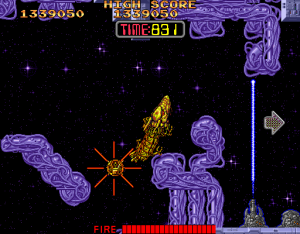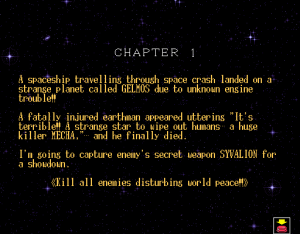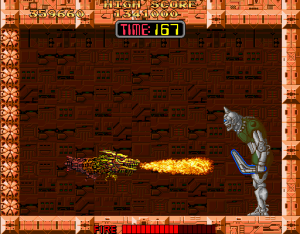The first thing I said to myself when getting this site up and running was “oh boy, I can’t friggin’ WAIT to talk about old Japanese Taito games!” And the first of said Taito games I want to look at is one that is oft overlooked in the West: Syvalion.
Syvalion was another creation of the late Fukio “MTJ” Mitsuji, who is perhaps best known for Bubble Bobble but was responsible for numerous Taito masterpieces (though personally, I’ll confess to wanting to like Rainbow Islands a lot more than I actually do like it). Syvalion is the third game by the Taito “Bubble Team” and considered another one of MTJ’s great works.
You’ll be hard pressed to see any affection for it outside of Japan, though. Syvalion doesn’t seem to have received any international releases, though a prototype “world” set of ROMs for use with MAME is floating about online. This is the only English version available, though the localization is… rough, to say the least. (So about par for the course for Taito arcade titles of this era.) It’s a truly fascinating game, though, so a closer look is certainly in order!
So, Syvalion is a trackball-controlled game that has the aesthetics of a shooter (space theme, mechanical enemies and backgrounds, et cetera), but is actually something quite different. The “ship” you control is a long, multi-segmented mechanical dragon, the titular Syvalion. Syvalion is actually kind of fragile despite its fierce appearance: while it can handle collisions with walls and barriers with nary a scratch, enemies and their fire will damage the craft quite easily (and quickly, as there’s no invincibility window after taking damage). Syvalion’s sole resource for destroying enemies is its incredibly destructive fire breath, which extends a ways forth from its mouth. The breath doesn’t work on everything, however – enemies surrounded by a glowing blue outline are fireproof and can’t be fully destroyed, though hitting them with fire can cause some of them to shrink or temporarily retreat. Flames can also be used for defense, as they reflect most kinds of enemy projectiles – a skill necessary to learn to avoid taking damage from most of the game’s bosses.
However, your breath is limited, and the longer you hold down the button, the smaller and less potent the flame becomes. It recovers over time, though moving faster increases its recharge rate. Like most arcade titles, Syvalion wants to keep you progressing until you either win or game over and plop another credit in, so besides the whole weapon-recharging bonus for scooting along quickly, you’ve also got both a time limit and cannon-fodder enemies that’ll reappear and hone in on you if you dally too long. (If you go under 100 timer ticks in the main part of the stage, you’ll find yourself pursued by a really creepy giant robotic head. Jeez, what was it with MTJ and ever-chasing, invincible floating heads?)
The timer adds to the feeling of being overwhelmed against tough odds – if you just try to fly blindly through the stages as fast as possible without using flames, you are bound to smack into a ton of stuff that will kill you really fast. If you inch along and try to roll in circles to restore flames and milk reappearing enemies for bonuses (a tempting prospect, since health drops are actually pretty common), you’ll find the timer running dangerously low. If you go in flames a-blazin’, you’ll run out of juice very quickly and possibly be without your most important resource when you most need it. Successful play in Syvalion requires a good balance of being careful, being fast, precision movements, and making quick judgments.
You’ll notice I haven’t said much about Syvalion’s story. That’s not (entirely) because it’s an action game with a rather laughable plot, it’s because the game has a unique structure that alters the story scenes and the level progression each time you play through it. You can start to the game with a harrowing tale about hijacking the Syvalion from enemy forces, or you might wind up with the Syvalion being a man-made weapon that gets a distress call, or even something else entirely. Potential plot points include alien brain parasites, human cloning, lost civilizations, escaping robotic captors, or even a crossover with Darius and/or Raimais (another fascinating Taito game of this era I really want to talk about). It’s all told via text between stages, and there are a huge number of threads and endings to discover.
It’s not just the story that changes, however. Syvalion was unique for its time in that it used an algorithm to randomize the path a player would take during each playthrough, meaning that playing the game twice would result in seeing a completely different set of levels and bosses. Special power-ups can be randomly bestowed at the beginning of a stage, and these range from destructive buzzsaw-like projectiles, an auto-firing multi-directional laser spray, even an “option” ship that looks suspiciously familiar. Sources I’ve read say that the algorithm for determining these outcomes involves a mix of score analysis, probability and your success at completing the bonus objectives the game asks of you (finishing a stage quickly, not taking a lot of damage, etc.).
In an era where arcade games were linear and demanded memorization and knowledge for players to achieve mastery, Syvalion was a mold-breaker, asking players to master a specific set of skills and be quick to apply them to a changing situation. It’s a game design that has much in common with modern roguelikes, forcing players to consider risks and react smartly in unpredictable situations – but with the added pressure of a timer and constantly respawning enemies. It’s definitely a tough, fast-paced game, and being able to 1CC it takes a lot of skill. (I’m still working on it.)
I would be remiss if I didn’t mention the soundtrack, which is one of ZUNTATA and Yasuhisa “YACK” Watanabe’s classics. While there are a few songs I find forgettable (the boss music especially), the good tracks are downright amazing, featuring a memorable, melodic quality that will stay with you long after you stop playing the game.
How can you play Syvalion, then? MAME is the obvious choice, though the trackball controls are awfully tough to simulate on a standard controller – a mouse might work better. (I have an actual trackball for a mouse, and it works pretty well, though it still seems a fair bit finicky at times. I’m still playing around with settings to get it to feel “right.”) There’s a SNES port of Syvalion by Toshiba EMI, and though it was set to release in North America through JVC (ads and promo material for it exist), the English-language edition of it is strictly Europe-only. It’s far from a terrible port – the game looks very close to the arcade version despite a reduction in resolution, and it manages to control as well as they could feasibly get it to handle on a SNES controller. The localization is a fair sight better than the arcade prototype, too. The real problem with it, however, is the soundtrack, which is completely different from the original arcade score. The music’s not exactly awful, but when you’re holding it up against one of ZUNTATA’s most fondly remembered scores, it has a lot to live up to. (And it certainly doesn’t.) I hear the X68000 port is stellar, though I have yet to try it. It’s also available on only the PlayStation 2 version of Taito Legends 2, which I’m ashamed to admit I don’t own. (Still need to get Taito Memories Joukan, as well…)
Syvalion represents a lot of things I love in gaming, especially stuff from around this time period. It’s strange, it’s inventive, and while it certainly has flaws, there’s a passion and imagination from the developers that’s evident throughout. If anything I have said here intrigues you, I highly recommend taking a look at the game for yourself.








One Comment